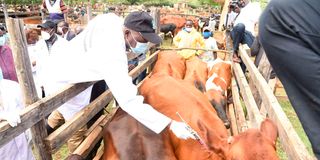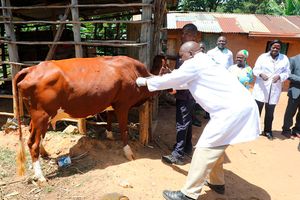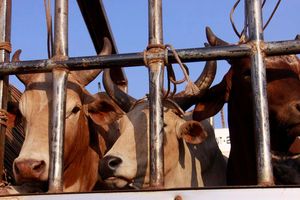Nine-county crisis: Garissa, Isiolo, Marsabit battling catastrophic livestock outbreaks

Cows being vaccinated against foot and mouth disease. A new wave of livestock disease outbreaks is spreading across several arid and semi-arid counties.
What you need to know:
- Multiple livestock diseases including foot and mouth, lumpy skin disease, and camel pox are spreading across Kenya's arid and semi-arid counties.
- The NDMA reports outbreaks in at least nine counties including Garissa, Isiolo, Marsabit, Baringo, and Narok West.
A new wave of livestock disease outbreaks is spreading across several arid and semi-arid (Asal) counties, posing a significant threat to pastoral and agro-pastoral livelihoods.
According to the National Drought Management Authority (NDMA), cases of foot and mouth disease have been reported in Garissa, Isiolo, and Marsabit, Isiolo, among others.
Foot-and-mouth disease, which causes painful blisters in animals' mouths and feet leading to significant production losses, has been particularly challenging to control due to its highly contagious nature. The disease is classified as "trade-sensitive" by the World Organization for Animal Health, meaning its presence restricts Kenya's ability to participate in international livestock markets.
"Suspected cases of foot and mouth disease were reported in Garissa (southern parts), Isiolo (pastoral and agropastoral livelihood zones among cattle), Moyale (Uran, Obbu, Butiye and Golbo wards), Samburu East, Tana River, Kitui, Meru (Amwathi in Igembe North and Nkiluthu and Kandebene in Tigania East), Narok West and Chepareria in West Pokot County," the NDMA said.
At the same time, outbreaks of lumpy skin disease - a contagious viral disease affecting cattle and water buffalo, characterised by skin nodules, fever, and other symptoms - have been reported in Baringo and Narok West, further endangering vulnerable communities dependent on livestock for survival.
According to the authority, Marsabit County is grappling with multiple disease outbreaks, including camel pox cases that were reported in Uran, Sololo, and Obbu wards, while sudden unexplained deaths in goats were reported in Quuq, Amballo, and Obbu.
Rabies cases
In addition, Peste des Petits Ruminants, a highly contagious viral disease that affects small ruminants, has also been reported in Marsabit County. In Forole, suspected rabies cases in donkeys were flagged by the authority, while Karare recorded unusually high dog mortalities, with clinical signs pointing to a likely outbreak of canine distemper.
Vector-borne diseases like East Coast Fever, anaplasmosis, and trypanosomiasis were also reported in Marsabit County.
Elsewhere, active disease surveillance revealed ongoing cases of lumpy skin disease and foot and mouth disease in Narok West Sub-county, and anthrax outbreaks in Narok’s Ilmotiok ward, Emurua Dikirr, and Katakala.
However, despite the widespread nature of the outbreaks, the NDMA said that mortality levels remain within "normal thresholds."
"Minimal mortalities attributable to disease were reported across the Asal counties, with the mortality rate falling within the normal threshold," said NDMA in its latest report.
Additionally, with water sources such as water pans drying up, both livestock and human populations are likely to face severe water shortages and forcing longer trekking distances to access essential supplies, a situation that will further weaken animals and reduce their market value.
In March, a mysterious disease struck Marsabit’s Hurri Hills in North Horr Constituency, killing at least 20 camels within a week and leaving dozens more critically ill.
The outbreak triggered panic among herders, who feared devastating losses unless urgent veterinary interventions were deployed.
The disease presented with symptoms including thick white nasal discharge, labored breathing, teary eyes, extended neck, swollen cervical and parotid lymph nodes, immobility, and eventual death within three to four days.


